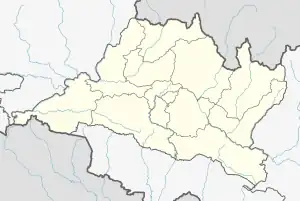Ratnanagar
Ratnanagar is a municipality in Chitwan District of Bagmati Province in Nepal. It is the second biggest municipality after Bharatpur Metropolitan City that was formed in 1997 through the merger of the former Village Development Committees Old-Ratnanagar and Panchakanya.[2] It is adjacent to Chitwan National Park, and serves as a gateway to the park. Agricultural products produced from Ratnanagar includes rice, maize, mustard and vegetables. This municipality is also a major place for production of poultry products and animal husbandry. Tourism is another source of income generation for the people in Ratnanagar. People are directly or indirectly dependent in tourism industry. Ratnanagar is also concerned in environment preservation so in order to preserve and protect environment, eco-friendly electric risk-shaw has also been introduced and available in different parts of this municipality. It lies on the bank of East Rapti River.
Ratnanagar
रत्ननगर | |
|---|---|
 Ratnanagar Location in Nepal  Ratnanagar Ratnanagar (Nepal) | |
| Coordinates: 27°37′N 84°30′E | |
| Country | |
| Province | Bagmati Province |
| District | Chitwan District |
| Established | 1997 |
| Government | |
| • Mayor | Mr. Narayan Ban (NCP) |
| • Deputy Mayor | Mrs. Bimala Duwadi (NCP) |
| Area | |
| • Total | 686 km2 (265 sq mi) |
| Elevation | 200 m (700 ft) |
| Population (2011) | |
| • Total | 69,851 |
| • Density | 100/km2 (260/sq mi) |
| Time zone | UTC+5:45 (NST) |
| Postal code | 44204[1] |
| Climate | Cwa |
| Website | www |
In 2014, the former Village Development Committees Bachhayauli and Pithuwa were merged into Ratnanagar.[3]
Sauraha that lies in Ratnanagar's vicinity is a touristic hub with many hotels, resorts and shops, as it borders Chitwan National Park. There is also an Elephant Breeding Station.[4]
Demographics
At the time of the 2011 Nepal census, Ratnanagar Municipality had a population of 70,226. Of these, 70.2% spoke Nepali, 16.6% Tharu, 3.9% Tamang, 2.6% Bhojpuri, 1.6% Newar, 1.2% Darai, 0.9% Gurung, 0.7% Magar, 0.7% Hindi, 0.6% Maithili, 0.3% Chepang, 0.1% Urdu, 0.1% Bote, 0.1% Rai, 0.1% Kumal and 0.1% other languages as their first language.[5]
In terms of ethnicity/caste, 33.1% were Hill Brahmin, 17.7% Tharu, 12.4% Chhetri, 6.7% Tamang, 6.4% Newar, 3.4% Kami, 2.9% Gurung, 2.9% Magar, 2.5% Musalman, 1.7% Damai/Dholi, 1.4% Sarki, 1.3% Darai, 1.2% Kumal, 1.1% Sanyasi/Dasnami, 0.7% Gharti/Bhujel, 0.5% Chepang, 0.5% Thakuri, 0.4% Kalwar, 0.3% Musahar, 0.3% Rai, 0.2% Badi, 0.2% Bote, 0.2% Teli, 0.1% Hajam/Thakur, 0.1% Kanu, 0.1% Majhi, 0.1% Mali, 0.1% Mallaha, 0.1% Terai Brahmin, 0.1% Kurmi, 0.1% Dusadh/Pasawan/Pasi, 0.1% Koiri/Kushwaha, 0.1% Sunuwar, 0.1% Halwai, 0.1% Kathabaniyan, 0.1% other Dalit, 0.1% Yadav and 0.1% others.[6]
In terms of religion, 87.9% were Hindu, 7.2% Buddhist, 2.5% Muslim, 2.0% Christian, 0.1% Prakriti and 0.2% others.[7]
Transportation
Ratnanagar lies on Mahendra Highway, one of the main highways in Nepal where highway passed just total length of 3 km.
Media
To Promote local culture and cast local news Ratnanagar has three community radio stations, Radio Arpan - 104.5 MHz, Radio Chitwan 94.6 MHz and Relation F.M
See also
References
- "Postal Codes of Nepal". Government of Nepal - Postal Service Department. Retrieved 1 September 2018.
- "Brief Introduction". Ratnanagar Municipality. Retrieved 1 September 2018.
- Municipal Association of Nepal (MuAN)
- "Sauraha aiming to extend tourists' stay". 24 December 2007. Archived from the original on 30 April 2008. Retrieved 1 September 2018.
- NepalMap Language
- NepalMap Caste
- NepalMap Religion
